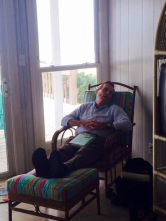For thirty years, I was a teacher.
I helped teach my own children at home; I taught adult basic education for two years in a prison in Hazelwood, North Carolina; I taught another two years in public high schools in Haywood County, North Carolina; I taught literature, history, and Latin to several hundred home-educated students over a period of 25 years.
I helped teach my own children at home; I taught adult basic education for two years in a prison in Hazelwood, North Carolina; I taught another two years in public high schools in Haywood County, North Carolina; I taught literature, history, and Latin to several hundred home-educated students over a period of 25 years.
Some of these students were academically talented and went on to prestigious universities; others attended lesser known colleges and community colleges; a few went directly into the military; a good number entered the work force. Some of these students had emotional problems; some endured difficult family situations or severe health issues; some showed ability in subjects such as composition and Latin while others struggled mightily to make a B; some displayed enormous talent outside the classroom in areas as varied as dance, rowing, robotics, and acting while others were mediocre in whatever they tried. (“Anything worth doing is worth doing badly.” G.K. Chesterton)
Of all the young people I taught, not one of them--not one—struck me as a snowflake.
Snowflake is a term applied these days to students who, according to one online site, are “more prone to taking offense and less resilient than other generations, or as being too emotionally vulnerable to cope with views that challenge their own.”
I did have students who brought personal difficulties into my classroom. Examples: In those 25 years, I remember two students who were cruel far beyond belief and quite possibly mentally ill; I had one young man who proclaimed himself gay and didn’t find the acceptance among his classmates that he expected; I taught a young woman who was a capable poet at the age of 17, but who was also confused by her sexual orientation.
But these were not snowflakes. They were young people struggling with personal problems or, in the case of the two cruel students, were so socially maladjusted as to be a threat to those around them.
Like others who read the news, I find the emotional fragility of some of our college students by turns amusing or baffling. I don’t understand the need for “safe spaces,” and the term “micro-aggressions” from my perspective should be limited to mosquitoes, chiggers, and bedbugs.
But these are not the young people—or the prisoners, for that matter—I knew in my classroom. When I think of my students, especially those registered as homeschoolers, I think of these words: resilient, determined, quirky, curious, kind, generous, hard-working, capable, funny (often unintentionally, which meant I reserved my laughter for my drive home), hopeful.
Doubtless a handful of our young people deserve the label of snowflake. Yet the vast majority, even as I write these words, are making their way through college and in the world, struggling with who they are and why they are here (I understand; I still struggle with those questions), but pushing ahead, searching, striving, achieving.
There is no snowflake generation. If you are past thirty, and if you doubt me, then put aside the media and the Internet, and look at the young people around you.
As for me, I don’t see snowflakes. I see sunshine.
Of all the young people I taught, not one of them--not one—struck me as a snowflake.
Snowflake is a term applied these days to students who, according to one online site, are “more prone to taking offense and less resilient than other generations, or as being too emotionally vulnerable to cope with views that challenge their own.”
I did have students who brought personal difficulties into my classroom. Examples: In those 25 years, I remember two students who were cruel far beyond belief and quite possibly mentally ill; I had one young man who proclaimed himself gay and didn’t find the acceptance among his classmates that he expected; I taught a young woman who was a capable poet at the age of 17, but who was also confused by her sexual orientation.
But these were not snowflakes. They were young people struggling with personal problems or, in the case of the two cruel students, were so socially maladjusted as to be a threat to those around them.
Like others who read the news, I find the emotional fragility of some of our college students by turns amusing or baffling. I don’t understand the need for “safe spaces,” and the term “micro-aggressions” from my perspective should be limited to mosquitoes, chiggers, and bedbugs.
But these are not the young people—or the prisoners, for that matter—I knew in my classroom. When I think of my students, especially those registered as homeschoolers, I think of these words: resilient, determined, quirky, curious, kind, generous, hard-working, capable, funny (often unintentionally, which meant I reserved my laughter for my drive home), hopeful.
Doubtless a handful of our young people deserve the label of snowflake. Yet the vast majority, even as I write these words, are making their way through college and in the world, struggling with who they are and why they are here (I understand; I still struggle with those questions), but pushing ahead, searching, striving, achieving.
There is no snowflake generation. If you are past thirty, and if you doubt me, then put aside the media and the Internet, and look at the young people around you.
As for me, I don’t see snowflakes. I see sunshine.






 RSS Feed
RSS Feed